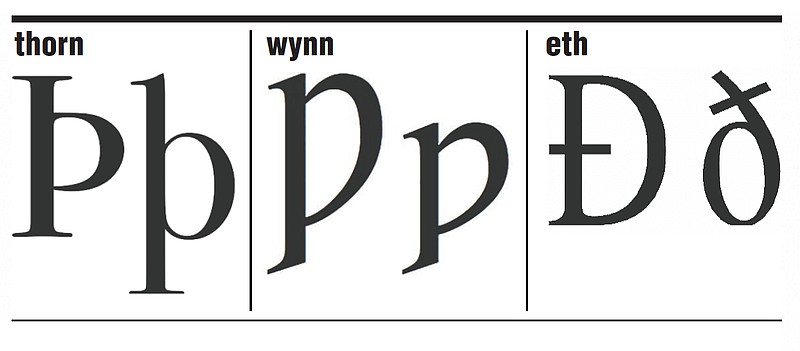I ran across a few letters that once were part of our alphabet but later faded away. One is called the thorn.
It represents the "th" sound. Because you make the sound by pushing air out of your mouth, it's called a "fricative." (Fricative is my favorite word of the month.)
I can't replicate a thorn on this computer. But if you imagine the head of Charlie Brown wearing a mortarboard, then turn it 90 degrees to the left, you have a thorn.
The thorn was from the Anglo-Saxon runic alphabet, and it presented itself in English after the Anglo-Saxons invaded the British Isles.
Here's where things may start to sound familiar. The printed form of the thorn looked like the letter "y." This is where we got phrases such as "Ye Olde Commodore Amiga 500." Most people would pronounce that first word as "yee" but it should be pronounced like "the."
Over time, the thorn got pulled and was replaced by the combination sound of "t" and "h."
The wynn was another runic letter that died off, despite its valiant effort to replace the doubled "u" in Old English. It represents the sound "w."
The wynn looks a lot like the thorn but is closer to what a latte cup on its side looks like.
The wynn replaced the "uu" for a time, but "uu" fought back and became the modern "w."
One letter used in Medieval English was called eth and made up of a "D" with a hyphen through it; the lowercase version looks like an "o" holding a cross above its head while stretching.
The eth came from the Danish edh, which happens to be among my favorite words to use in Scrabble.
The BBC website says eth also was called "thok." This makes me wonder whether it has Klingon roots.
The eth was the same sound as the thorn. Maybe someone decided that redundancy was inefficient.
A SEMI-REGULAR REVIEW
In sentences, the subject and verb need to agree. This means that if the subject of the sentence is a single thing, then the verb, or action word, that goes with it has to be for a single thing, too.
It's easy to understand when the sentences are straightforward:
The boy has freckles.
The twins have freckles.
But all sorts of vexing things such as apostrophes and joining words complicate things.
When words are connected by an "and," the verb has to be for a plural thing:
The eggs and cream need to be at room temperature.
The moon and stars fill the night sky.
When the subject of the sentence has two nouns connected by an "or" or a "nor," the verb needs to agree with the noun closer to it. This sort of sentence sounds odd to me, so I almost always try to find a different way to write the sentence.
I'm not sure whether the pens or the paper is what I like best about the stationery store.
I'm not sure whether the paper or the pens are what I like best about the stationery store.
Contractions such as "there's" confuse people. The "is" needs to go with a singular noun.
Wrong: There's a million reasons I don't want to go to this party.
Right: There are (or there're) a million reasons I don't want to go to this party.
Wrong: There's changes coming to the cafeteria.
Right: There are changes coming to the cafeteria.
Right: There's a pool of water on the floor.
Some words — such as "one," "each," "no one" and "everyone" — are singular and need a singular verb. This really trips up people.
Wrong: Only one of you guys are going to win.
Right: Only one of you guys is going to win.
Wrong: Each of the candy bars have peanuts.
Right: Each of the candy bars has peanuts.
Sources: Oxford Dictionaries, Merriam-Webster, BBC, Word Origins, Mental Floss, Purdue University, Associated Press Stylebook.
Send email to:
bkwordmonger@gmail.com
Style on 11/12/2018
